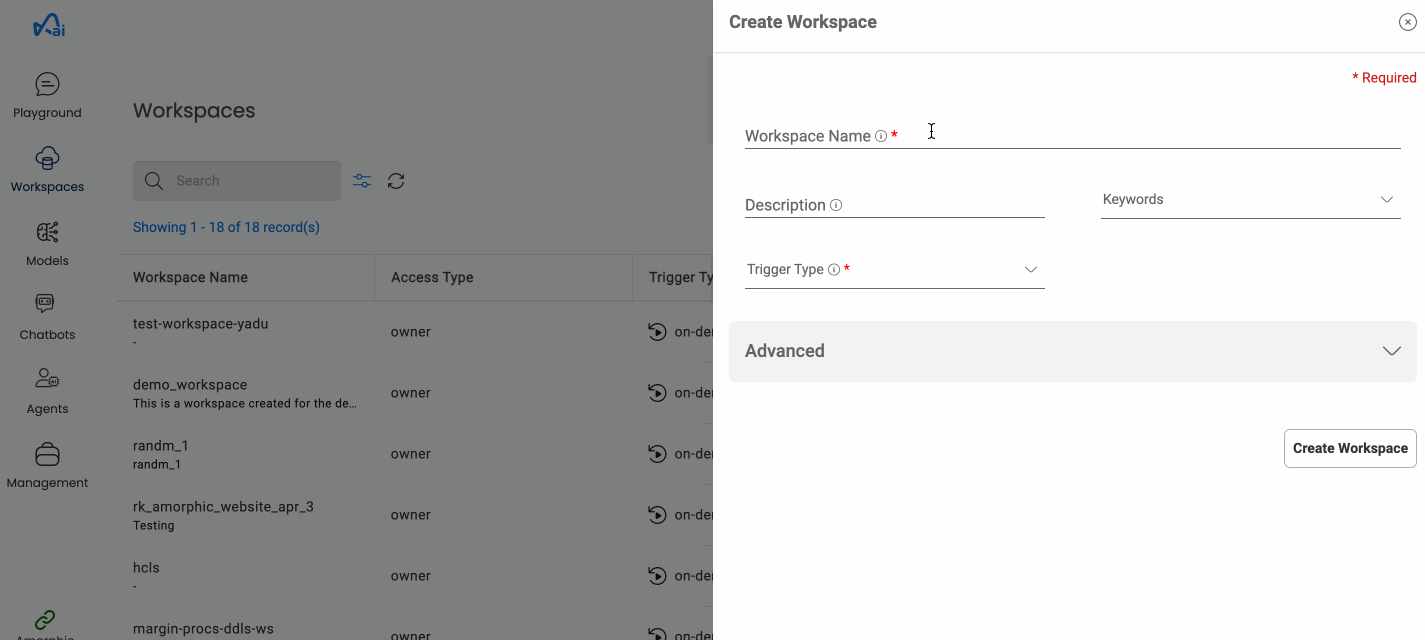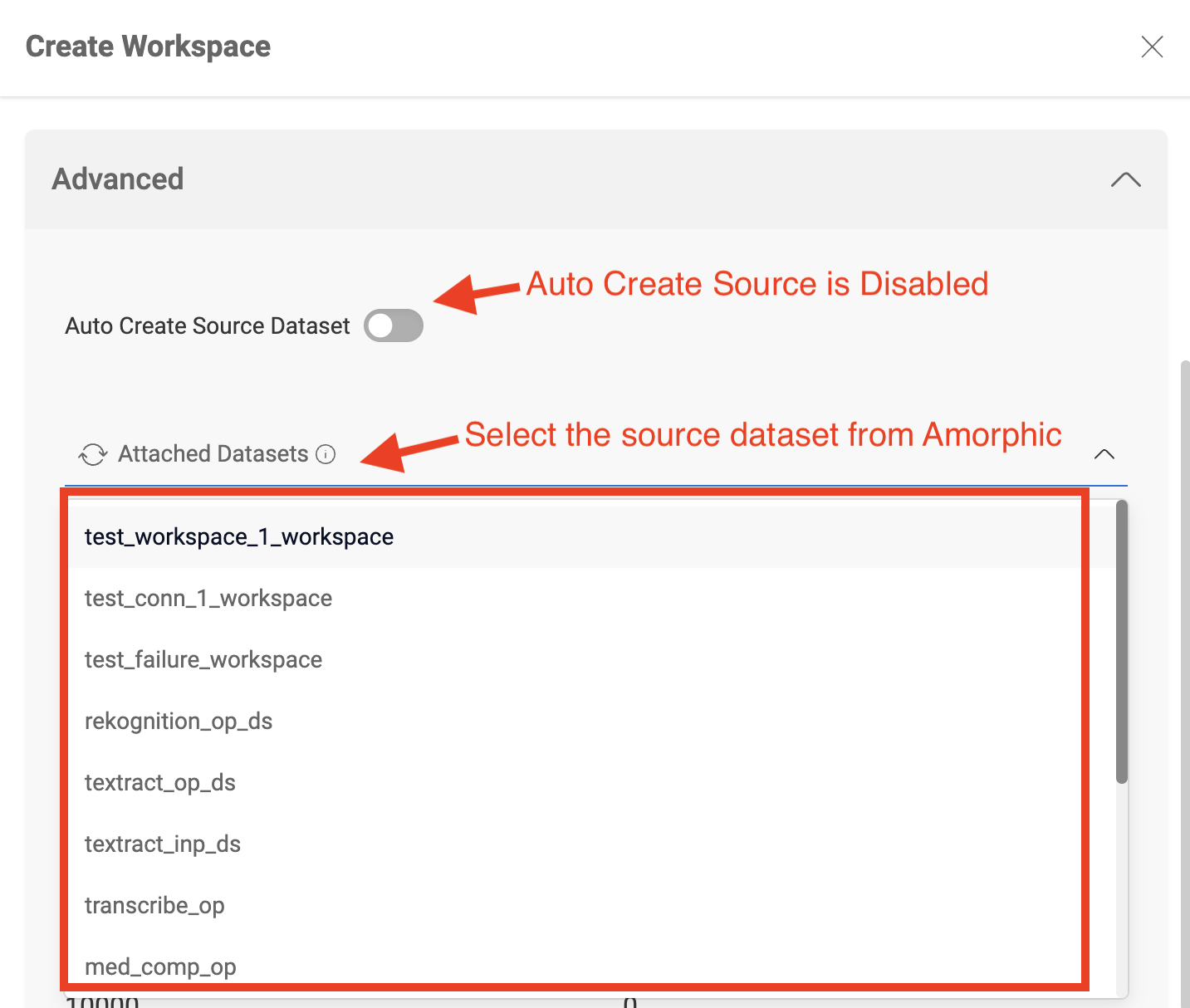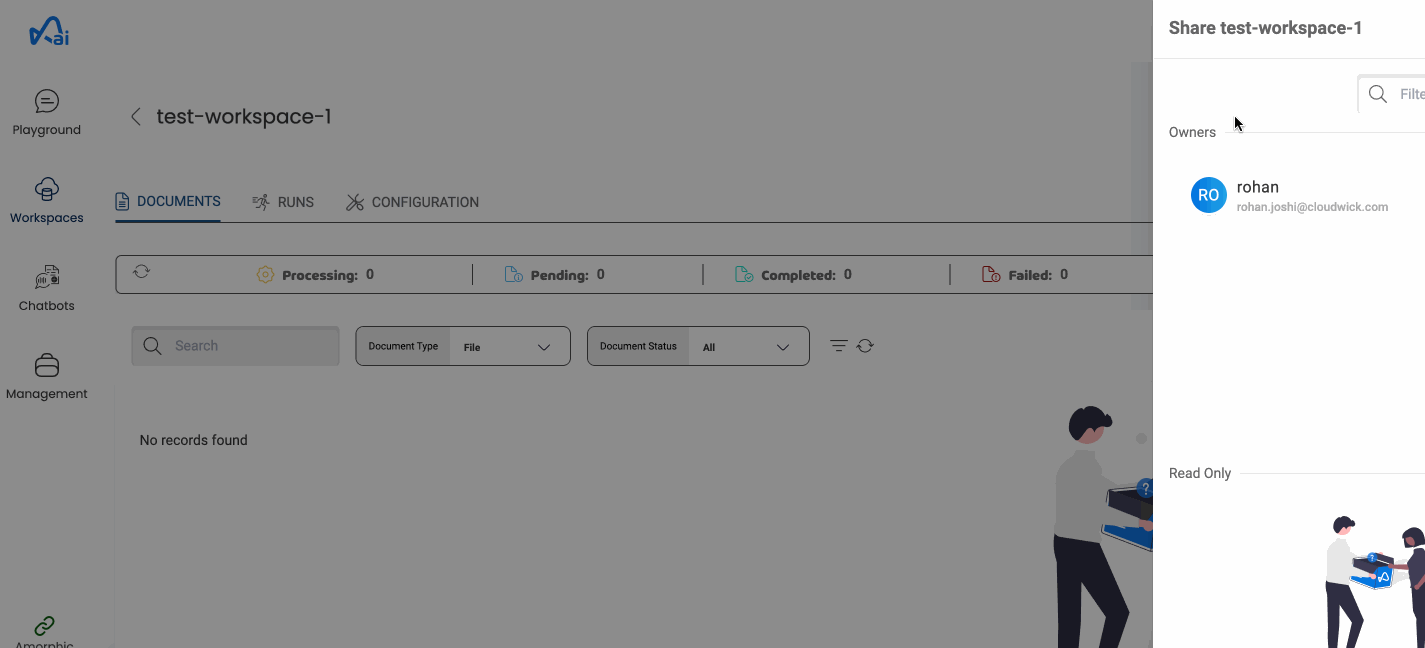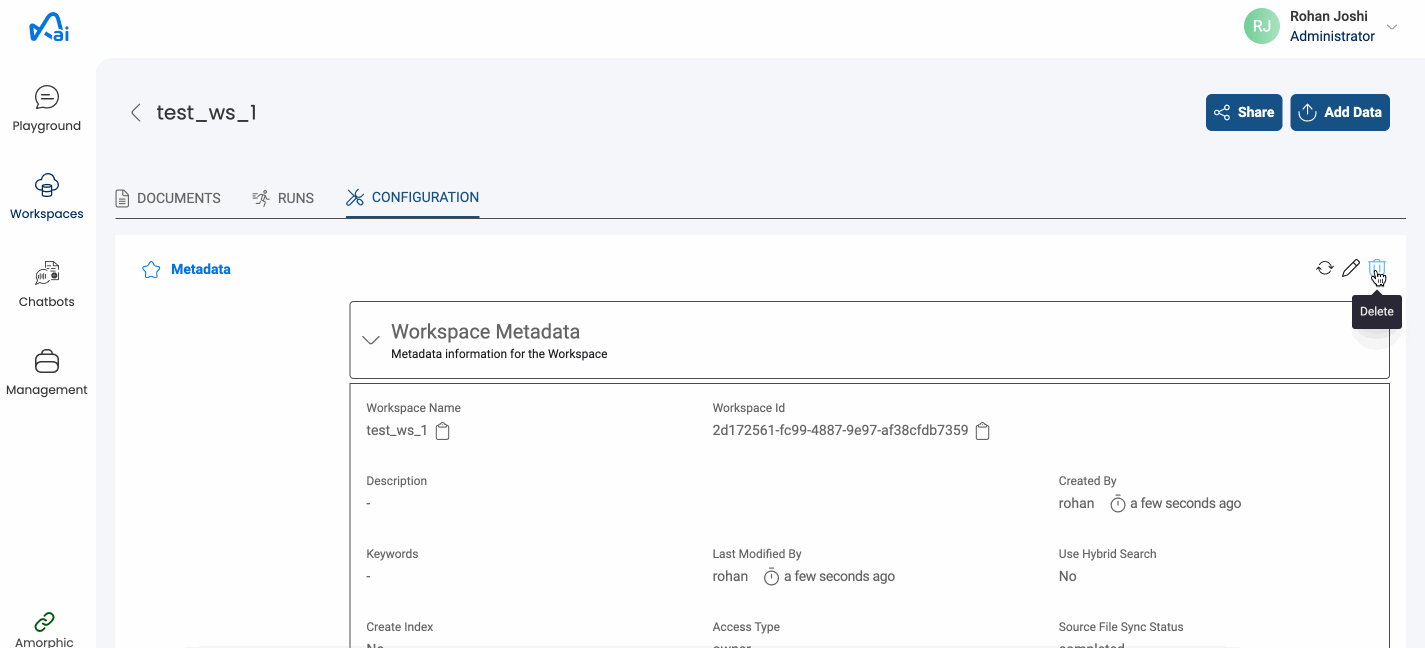Workspaces
The workspace, serving as the locus for data storage within the Amorphic AI system, enables users to create and store embeddings for designated CSV, TXT, and PDF files. Amorphic seamlessly vectorizes this data, storing it in the vector database, which functions as a Retrieval Augmented Generation (RAG) source. Once documents linked to a workspace undergo processing, users gain access to the data through the chat playground, allowing them to pose queries directly relevant to the processed documents for enhanced interactivity and insightful analysis.
How to create a Workspace?
- Select Workspace tab from the Services in the left nav and Click on
+ New Workspace - Fill in the required fields (Details listed below) and click on
Create Workspacebutton.
Following fields are needed to create a workspace:
| Properties | Details |
|---|---|
| Workspace Name | A name for the Workspace. This should be unique across the platform. |
| Trigger Type | There are three trigger types:
|
| Schedule Expression | Time-Based trigger type require a schedule expression. i.e., Every 15 min, daily, etc. Read more |
| Description | Description of the workspace being created. |
| Keywords | Keywords indexed & searchable in app. Choose meaningful keywords to flag related workspaces & easily find them later. |
| Auto Create Source | Enabling this option allows user to auto-create the source dataset required for the Workspace or user can attach source datasets from the list of their Amorphic datasets by disabling this option. |
| Attached Datasets | User can attach a list of source datasets from Amorphic as a data source for the workspace. The datasets must have S3 or S3-Athena as the Target Location and can have FileType as either csv, txt, pdf or others. Currently only one dataset can be attached to a workspace |
| Create Index | By default, pgVector performs exact nearest neighbor search, which provides perfect recall. You can add an index to use approximate nearest neighbor search, which trades some recall for performance. Unlike typical indexes, you will see different results for queries after adding an approximate index |
| Use Hybrid Search | Use Hybrid search for getting results |
| Embeddings Model | The model to use for generating embeddings |
| Languages | Input languages of documents. Currently only English is supported |
| Metric | Metric to use for semantic search. Defaults to cosine |
| Chunk Size | Chunk size is the character limit of each chunk, which is then vectorized. Value must lie between 100 and 10000, both included |
| Chunk Overlap | Overlap between the created chunks. Overlap must be greater than 0 and less than chunk size |
Below image shows how to create a new workspace

How to add documents in a workspace?
User can run embeddings process on documents after adding them to a workspace. There are four types of documents which can be added to a workspace.
Files
There are two ways to import files into a workspace.
1. From existing Amorphic datasets
User can import files from an existing Amorphic dataset to Workspace by specifying the source dataset at the time of Workspace creation.
To import files from an Amorphic source dataset, disable Auto Create Source in the Advanced options and select a Source Dataset at the time of Workspace creation.
All the files metadata in the Amorphic source dataset will be imported into the Workspace after the completion of store creation and this will be an asynchronous process.

2. By manual file upload
User can also upload files to the Workspace whenever it required. To upload files to the Workspace follow below steps:
- Select the Workspace that you want to upload files to and click on the
Add Datain the top right corner. - Select the
Upload Filestab. - Select the dataset that you want to upload the files to.
- Add the files that you want to upload and click the
Upload Filesbutton.
Text
Users can also add some text relevant to the workspace along with a title using the Add Text tab.
Q&A
Users can add a Question and the corresponding answer to the Workspace using the Add Q&A tab.
Websites
Users can also add some websites whose content is relevant to the workspace. The data from these websites will be retrieved using web crawling. Users can specify the either the base website address or the sitemap address. They can also configure whether to follow the nested links within the webpage and the limit on the number of webpages to be crawled.
Below image shows how to add different types of documents to the Workspace

How to Run a Workspace?
There are 3 ways to run a workspace based on the Trigger-Type.
- On-Demand
- File-Based
- Time-Based
1. On-Demand
As the name suggests, users can run On-Demand Workspaces whenever they want.
Following are the step to run a workspace on-demand.
- Select the workspace you want to run and click on the
RUNStab. - Click on the
Trigger Runbutton and select the RunType from the drop-down list. - The RunType can be any of the following:
- All Documents: Embeddings generation operation will run on all files except already processing files.
- Select Document: User can select a list of documents to be picked up. All the documents in that list that are not already being processed will be picked.
- Latest Documents: All unprocessed documents will be picked up.
- Failed Documents: All documents on which embeddings generation process failed will be picked up.
- Click on the
Trigger Runbutton and to start the Workspace run.
After the completion of Workspace run, user will get and email with all the details of that run.
Below image shows how to run a Workspace

2. Time-Based
User have the option to run a Workspace on a schedule basis. The Workspaces with the Trigger-Type as Time-Based will run automatically based on the schedule expression specified.
3. File-Based
If the Document Trigger type is File-Based, then whenever a document is added to the Workspace, it'll trigger a new run on that workspace automatically.
A new run will be initiated for every document added to the Workspace; for instance, adding 50 documents will trigger 50 new runs.
How to edit a Workspace?
User can edit details of a Workspace after the creation of that Workspace.
- Select the Workspace you want to edit and click on
CONFIGURATIONtab. - Click on the edit icon in the Metadata and update the required details then click on
Update Workspacebutton.
Below image shows how to edit a Workspace

How to share a Workspace?
Owners of the Workspace can share it with other users in the Amorphic AI. There are two types of access control for Workspace, Owner Access and Read-only Access. Owners of the Workspace can do any operation on those Workspaces(run, add documents, edit etc.) whereas as the read-only users can only view the Workspace.
To share a Workspace with other users in the Amorphic AI, follow these steps:
- Select the Workspace that you want to share and click on
Sharebutton in the top right corner. - Click on the
+(Provide Access) button. - Select the username of the user to whom you want to share the Workspace with and also select the access type(Owner or Read-only) and click submit button.
Below image shows how to share a Workspace with other users.

How to delete a Workspace?
Users can delete a Workspace when there is no runs currently happening on that Workspace. Follow these steps to delete a Workspace:
- Select the Workspace that you want to delete and go to
CONFIGURATIONtab. - Click on the delete icon in the Metadata section and click on the Delete Workspace button to confirm the deletion.
Below image shows how to delete a Workspace

Deleting the Workspace will only delete all the Workspace related metadata from AI app. The corresponding datasets that are created as part of Workspace will still exist in Amorphic.